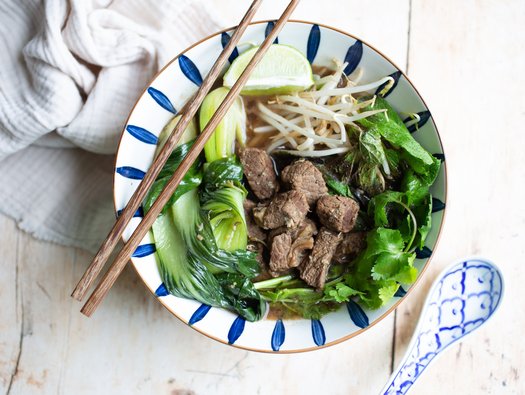Thai beef noodle soup

A delicious, high protein colourful dish low in salt, potassium and phosphate.

A delicious, high protein colourful dish low in salt, potassium and phosphate.
6 garlic cloves, peeled
20 coriander stems, cleaned and roughly pounded
1 teaspoon whole black peppercorns
1 tablespoon vegetable oil
500g lean stewing beef or brisket, cut into 3cm cubes
3 whole star anise
1 cinnamon stick
2 tablespoons reduced-salt soy sauce
1.4 litres hot low-salt beef stock
400g pak choi bulbs, cut into quarters
200g rice noodles
200g beansprouts
20g mint leaves
1 lime, cut into 4 wedges
20g coriander leaves
Crush the garlic cloves, coriander stems and peppercorns to a rough paste in a pestle and mortar.
Heat the oil in a large saucepan over a high heat. Cook the garlic mixture for 30 seconds until fragrant. Add the beef and cook for 3-4 minutes or until evenly browned all over. Add the star anise, cinnamon stick and soy sauce and mix thoroughly, to let the flavours absorb into the meat. Now add the 1.4 litres of hot low-salt beef stock and bring to a simmer. Reduce the heat to low, cover the pan and simmer gently for 90 minutes until the beef is tender.
Scoop the pieces of beef from the broth and set aside until ready to serve.
Cook the rice noodles according to the pack instructions, then set them aside.
While the noodles are cooking, remove the cinnamon stick and star anise from the broth and discard. Place the pak choi in the broth and simmer for 2-3 minutes to gently cook the cabbage.
When the pak choi is cooked, take it off the heat. Divide the noodles between four large bowls, top with raw bean sprouts, mint leaves, coriander leaves and the braised beef. Pour over the beef broth and pak choi and squeeze over a wedge of lime.
The rice noodles are the main source of carbohydrate in this dish and the values have been provided for those who have trained in insulin adjustment.
Although this dish does contain some potassium, overall, when keeping to the portion sizes suggested, this dish is low in potassium.
This dish is low in phosphate, however, it does contain some phosphate, mainly provided by the beef, therefore, if you have been prescribed a phosphate binder ensure you take these them with this dish.
This recipe is high in protein, provided by the beef, which makes it suitable for anyone receiving dialysis. For those advised to reduce their protein, you could consider making this recipe using 450g of Quorn pieces or 500g tofu in place of the beef, as suggested in the vegetarian and vegan options below.
To make this dish vegetarian or vegan, you can replace the beef stock with vegetable stock, and the beef with 450g of Quorn pieces. This would also lower the protein and potassium content of the dish.
Use a gluten free soy sauce, such as Tamari, to make this dish gluten free.
Although salt has not been added to this dish, it is not low in salt; this is due to the added soy sauce and beef stock cube, both of which contain salt. To help keep the salt in this dish as low as possible, use a homemade beef stock with no added salt or be sure to use reduced salt options.
This dish is best eaten when freshly made.
If you have been advised to follow a fluid restriction, remember to include this soup in your daily fluid allowance.
By giving us your email address, you're giving us permission to send you the latest news from Kidney Care UK. Further information about how we protect and use your personal data is available in our Privacy policy. If you would like to change the way we communicate with you at any time please email [email protected]. You can unsubscribe at any time by using the link at the bottom of every email we send.